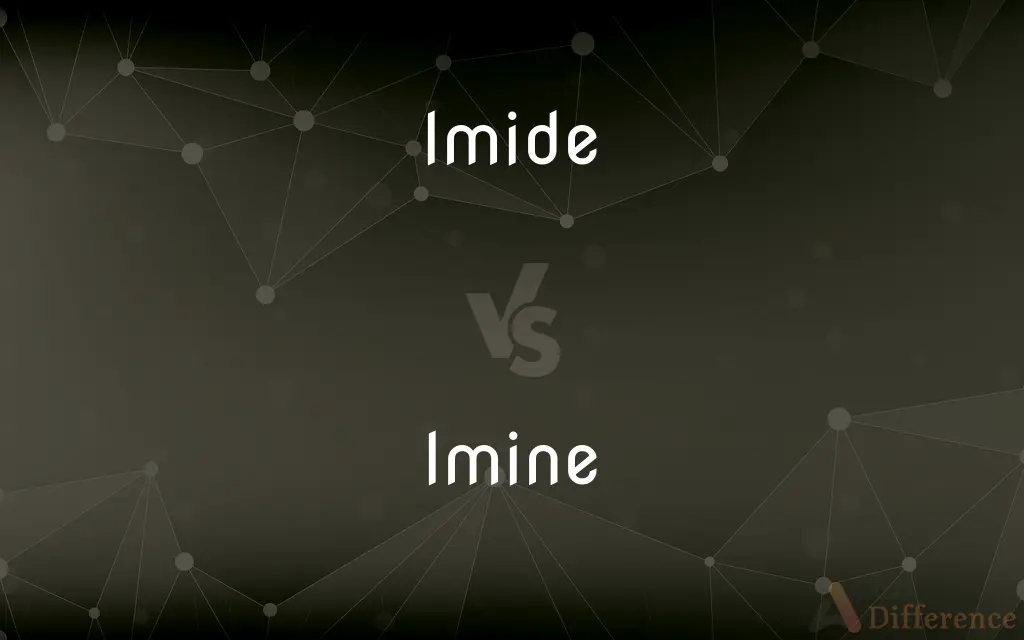Imide vs. Imine — What's the Difference?
Edited by Tayyaba Rehman — By Fiza Rafique — Updated on April 19, 2024
Imides are derived from dicarboxylic acids and feature a nitrogen atom double-bonded to oxygen; imines are formed from primary amines and aldehydes, featuring a carbon-nitrogen double bond.

Difference Between Imide and Imine
Table of Contents
ADVERTISEMENT
Key Differences
Imides are chemical compounds derived from dicarboxylic acids where a nitrogen atom is bonded to two carbonyl groups. On the other hand, imines are formed by the condensation of primary amines and aldehydes, resulting in a carbon-nitrogen double bond.
Structurally, imides exhibit a more complex arrangement due to their involvement with two carbonyl groups, whereas imines are simpler, consisting of a double bond between carbon and nitrogen without any oxygen atoms directly bonded to nitrogen.
In terms of stability, imides are generally more stable due to their resonance structures involving oxygen atoms. In contrast, imines are less stable and more reactive, often serving as intermediates in organic synthesis.
Imides are commonly used in the production of high-performance polymers and resins, thanks to their thermal stability and mechanical strength. Imines, however, are crucial in organic synthesis, particularly in the formation of a variety of other chemical compounds through reactions like reductive amination.
The nomenclature for imides often includes the suffix "-imide" after the name of the parent dicarboxylic acid, indicating their derivation. Imines are usually named by replacing the suffix "-al" from aldehydes with "-imine".
ADVERTISEMENT
Comparison Chart
Composition
Nitrogen double-bonded to two carbonyls
Carbon-nitrogen double bond
Derived From
Dicarboxylic acids
Primary amines and aldehydes
Stability
More stable, less reactive
Less stable, more reactive
Common Uses
High-performance polymers, resins
Organic synthesis intermediates
Example Compounds
Phthalimide, succinimide
Benzylideneamine, acetone imine
Compare with Definitions
Imide
Imides can act as ligands in coordination chemistry.
Some imides stabilize metal centers in catalysis.
Imine
Formed through the reaction of aldehydes with primary amines.
Acetone imine forms from acetone and ammonia.
Imide
A compound with a nitrogen atom bonded to two carbonyl groups.
Phthalimide is used in the synthesis of pharmaceuticals.
Imine
A compound featuring a carbon-nitrogen double bond.
Benzylideneamine is a simple aromatic imine.
Imide
Often derived from the condensation of dicarboxylic acids.
Succinimide is derived from succinic acid.
Imine
Plays a crucial role as intermediates in organic synthesis.
Imines are key in the synthesis of many alkaloids.
Imide
Found in polymers like polyimide known for high heat resistance.
Polyimide films are used in electronic applications.
Imine
Known for their susceptibility to hydrolysis.
Environmental moisture can rapidly hydrolyze imine bonds.
Imide
Used in various industrial applications for their stability.
Nylons containing imide groups are particularly tough.
Imine
Useful in the synthesis of amines and other nitrogen-containing compounds.
Imines are used in reductive amination.
Imide
In organic chemistry, an imide is a functional group consisting of two acyl groups bound to nitrogen. The compounds are structurally related to acid anhydrides, although imides are more resistant toward hydrolysis.
Imine
An imine ( or ) is a functional group or chemical compound containing a carbon–nitrogen double bond. The nitrogen atom can be attached to a hydrogen (H) or an organic group (R).
Imide
An acidic organic compound containing two carbonyl groups bonded to ammonia or to a primary amine.
Imine
A highly reactive organic compound containing an NH group doubly bonded to a carbon atom.
Imide
A strongly basic anion, NH2-, or a salt containing it.
Imine
(organic chemistry) Any of a class of organic nitrogen compounds having the general formula R2C=NR; they are tautomeric with enamines.
Imide
(organic chemistry) a form of amide in which the nitrogen atom is attached to two carbonyl groups - R1CONHCOR2
Imide
A compound with, or derivative of, the imido group; specif., a compound of one or more acid radicals with the imido group, or with a monamine; hence, also, a derivative of ammonia, in which two atoms of hydrogen have been replaced by divalent basic or acid radicals; - frequently used as a combining form; as, succinimide.
Imide
Any of a class of organic compounds that contain the divalent radical -CONHCO-
Common Curiosities
Can both imides and imines participate in hydrogen bonding?
Imides can participate in hydrogen bonding due to the presence of oxygen, while imines with only a nitrogen atom might engage in weaker hydrogen bonds.
What are the key physical properties of imides compared to imines?
Imides are typically more rigid and have higher melting points, whereas imines are generally more volatile and have lower melting points.
What role do imides play in biological systems?
Imides are not commonly found in biological systems, but when present, they can contribute to the stability of biomolecules like peptides and proteins.
How does the reactivity of imines with nucleophiles compare to that of imides?
Imines are more reactive with nucleophiles due to their electrophilic carbon, while imides, being more stable, react slower and under more stringent conditions.
Are imides or imines more soluble in water?
Imides are generally less soluble in water due to their bulky structure and the presence of nonpolar groups, whereas imines vary in solubility based on their specific structure but tend to be more soluble than imides.
How do the chemical synthesis processes differ between imides and imines?
The synthesis of imides usually involves heating dicarboxylic acids with amines or ammonia, while imines are formed at room temperature through the condensation of aldehydes and amines.
What are the environmental impacts of imides and imines?
Both compound types can present environmental risks if not managed properly, particularly imines which are more reactive and can form toxic byproducts.
How do imides and imines interact with metals in catalytic processes?
Imines can act as ligands and intermediates in metal-catalyzed reactions, whereas imides are less likely to participate directly in catalytic cycles but may stabilize metal catalysts through their backbone.
Are imides or imines more likely to be used as solvents?
Neither imides nor imines are commonly used as solvents due to their specific reactivity and stability characteristics.
How do imides and imines behave under acidic and basic conditions?
Imides are stable under a wider range of pH conditions, whereas imines can hydrolyze under acidic or basic conditions.
What safety concerns are associated with handling imides and imines?
Both imides and imines require careful handling; imines especially need protection from moisture and air to prevent degradation and polymerization.
Can imides and imines be used as dyes or pigments?
Imines are more commonly used in the synthesis of dyes due to their ability to form colorful complexes with metals, while imides are not typically used for this purpose.
How do the molecular weights of typical imides and imines compare?
Imides generally have higher molecular weights due to their more complex structures involving more atoms, compared to the generally lighter imines.
What is the impact of chain length on the properties of imides and imines?
Increasing the chain length in imides increases their thermal stability and melting points, whereas in imines, it may enhance solubility in organic solvents and reduce reactivity.
What future applications are being researched for imides and imines?
Research into imides focuses on developing new polymeric materials with enhanced properties, while for imines, ongoing research aims to exploit their reactivity for creating novel organic synthesis methodologies.
Share Your Discovery

Previous Comparison
Balayage vs. Ombre
Next Comparison
Downstream vs. UpstreamAuthor Spotlight
Written by
Fiza RafiqueFiza Rafique is a skilled content writer at AskDifference.com, where she meticulously refines and enhances written pieces. Drawing from her vast editorial expertise, Fiza ensures clarity, accuracy, and precision in every article. Passionate about language, she continually seeks to elevate the quality of content for readers worldwide.
Edited by
Tayyaba RehmanTayyaba Rehman is a distinguished writer, currently serving as a primary contributor to askdifference.com. As a researcher in semantics and etymology, Tayyaba's passion for the complexity of languages and their distinctions has found a perfect home on the platform. Tayyaba delves into the intricacies of language, distinguishing between commonly confused words and phrases, thereby providing clarity for readers worldwide.
















































